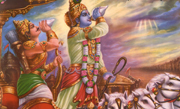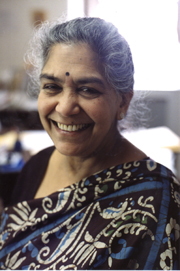|
by Sigalit Hoffman
Concordia’s first-ever International Conference on the Mahabharata,
held over three days last weekend, was open to academics and lay people,
and allowed Canadian graduate students in the field to attend for free.
“Travel costs alone are enough to deter graduate students from participating
in conferences, so we’ve particularly encouraged these students in
order to help them get expert feedback and to hone their skills as both
scholars and presenters,” said Concordia graduate student and conference
co-organizer Johanne Rabbat. “We’ve included graduate students
in our conference because we want to help them hone their skills as scholars.”
New insights into the text
“I decided to come here so I can get some new insight as to how to
approach the text,” said Master’s student Sherry-Ann Singh,
who is from Trinidad. “It has so far taught me what to look for in
my studies. A lot of [different] philosophies are coming out here that
I didn’t know before. In that way, it’s very enlightening.”
The holder of the Chair in Hindu Studies, Dr. T.S. Rukmani, organized
the conference to provide a venue for scholarly work on the Mahabharata.
About 40 experts attended.
“There are two epics in India, the Ramayana and the Mahabharata,
but the Mahabharata has not been given much attention, largely
because of its size,” she said. “However, there has been a lot
of scholarship, and discussion on many levels, from the notion of dharma
to the depiction of the characters.”
The Mahabharata is a 100,000-stanza epic poem that tells the story
of the descendants of King Bharata. The Pandava brothers lose their kingdom
to their Kaurava cousins and then struggle to gain it back. The battle
claims many lives and the story illustrates the futility of war. Other
stories and discussion often interrupt the main story.
As a whole, the Mahabharata is not only an important part of Hindu
mythology, it is also considered the first history of India and a moral
guidebook. It contains the Bhagavad-Gita, a discourse on courage
and morality that is a central part of the Hindu literary canon.
The keynote speaker who opened the conference with an address to about
200 participants was Gerald Larson, who is the Rabindranath Tagore Professor
of Indian Cultures and Civilizations at Indiana University in Bloomington.
Experts came from India, Israel, Norway and Australia to examine different
aspects of the epic. The topics ranged widely, from “Applied Acoustics
in the Mahabharata” (a presentation by Concordia’s chair
of the Mechanical Engineering, Dr. Rama B. Bhat) to “Mahabharata
as the Encyclopedia of Indian Morality and Culture.”
“The Mahabharata represents the ancient history not only of
India but of mankind,” said Royal Hindu Society president Rupnarine
Singh. “It is the accumulation of all the knowledge and experience
relevant to mankind.”
Dr. Singh, a cardiologist and owner of a Westmount medical clinic, came
to the conference to learn and to grow spiritually.
“People are grappling with the meaning of their duties and obligations
in society,” he said. “I try to make a contribution, and to
receive some insight,” he said.
|





